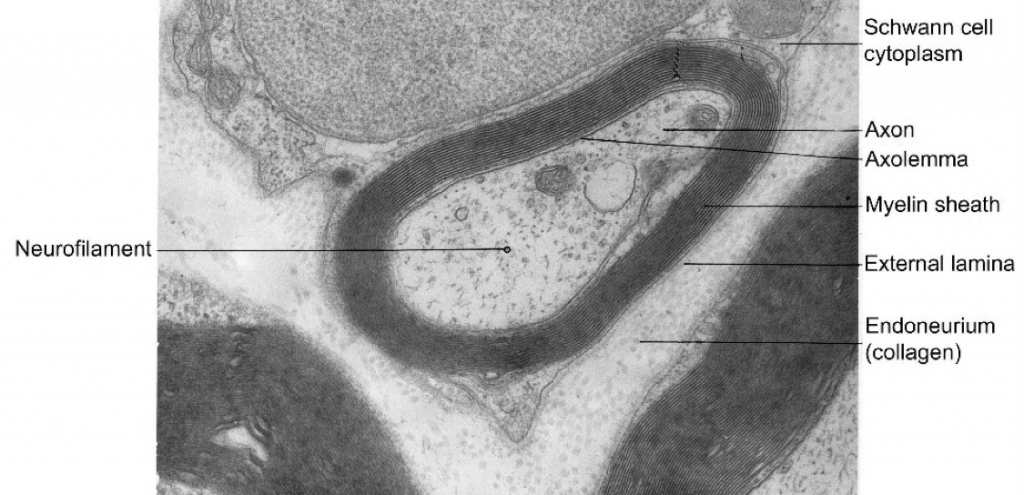Basics: neuroscience and psychophysics
8 Conduction Velocity and Myelin
Learning Objectives
Understand what myelin is
Understand how myelin increases conduction velocity
Myelin
The insulation for axons in the nervous system is provided by glial cells: oligodendrocytes in the CNS, and Schwann cells in the PNS. Although the method by which each cell is connected to the axon segment that it insulates may differ, the process of myelinating an axon segment is largely similar in both situations. This suggests that while the specific mechanisms may vary, there are fundamental similarities in how myelination occurs across different types of cells. Myelin is a lipid-rich sheath that surrounds the axon and by doing so creates a layer that enables the transmission of electrical signals along the axon to travel more efficiently. The lipids in myelin are essentially the phospholipids of the glial cell membrane. Myelin, however, is more than just the membrane of the glial cell. It also includes important proteins that are integral to that membrane. Some of the proteins help to hold the layers of the glial cell membrane closely together. Myelination is especially important in the central nervous system as it “benefits motor, sensory, and cognitive functions of the brain” because of the speed of action potentials that carry the important information into the brain (Yu, 2023).

Conduction velocity
Myelination improves the conduction velocity—the speed with which action potentials travel—in axons. Axon diameter also affects conduction velocity; fatter axons carry action potentials faster. So there are two factors that determine how fast an action potential travels down an axon: diameter and myelination (Suzuki, 2010). Axon diameter and myelination are correlated: the skinniest axons (< 1 micron in diameter) are also unmyelinated (often called C-fibers; a good example is found in the neurons that carry pain and temperature information from the skin to the spinal cord). They carry action potentials the most slowly, about 1 meter/second (walking speed). Axons fatter than 1 mm in diameter are generally myelinated. The fattest myelinated axons can carry action potentials faster than 100 m/s—race car speeds! Mechanical (pressure) sensors in our skins and motor neurons have fat, myelinated axons, so they can do their jobs rapidly.
Disorders of nervous tissue
Several diseases can result from the demyelination of axons. The causes of these diseases are not the same; some have genetic causes, some are caused by pathogens, and others are the result of autoimmune disorders. Though the causes are varied, the results are largely similar. The myelin insulation of axons is compromised, making electrical signaling slower.
Multiple sclerosis (MS) is one such disease. It is an autoimmune disease. The antibodies produced by lymphocytes (a type of white blood cell) mark myelin as something that should not be in the body. This causes inflammation and the destruction of the myelin in the central nervous system. As the insulation around the axons is destroyed by the disease, scarring becomes obvious. This is where the name of the disease comes from; sclerosis means hardening of tissue, which is what a scar is. Multiple scars are found in the white matter of the brain and spinal cord. The symptoms of MS include both somatic and autonomic deficits. Control of the musculature is compromised, as is control of organs such as the bladder.
Guillain-Barré (pronounced gee-YAN bah-RAY) syndrome is a demyelinating disease of the peripheral nervous system. It is also the result of an autoimmune reaction, but the inflammation is in peripheral nerves. Sensory symptoms or motor deficits are common, and autonomic failures can lead to changes in the heart rhythm or a drop in blood pressure, especially when standing, which causes dizziness.
Exercises
CC LICENSED CONTENT, SHARED PREVIOUSLY
OpenStax, Anatomy and Physiology Section 12.2 Nervous Tissue
Provided by: Rice University.
Access for free at https://openstax.org/books/anatomy-and-physiology/pages/1-introduction
License: CC-BY 4.0
Adapted by: Amalia Cotto
Susuki, K. (2010) Myelin: A Specialized Membrane for Cell Communication. Nature Education 3(9):59.
Yu Q, Guan T, Guo Y, Kong J. The Initial Myelination in the Central Nervous System. ASN Neuro. 2023 Jan-Dec;15:17590914231163039. doi: 10.1177/17590914231163039. PMID: 36974372; PMCID: PMC10052612.

